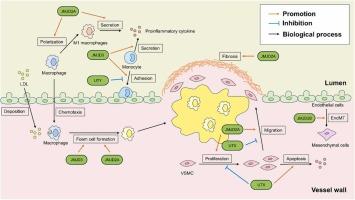心脑血管病JMJD蛋白解码:从结构到功能
IF 12.4
1区 医学
Q1 CELL BIOLOGY
引用次数: 0
摘要
心脑血管疾病仍然是全世界死亡和残疾的主要原因。它们的易感性与环境因素引发的表观遗传修饰密切相关。Jumonji C结构域(JMJD)蛋白家族由Fe 2 +和2-氧葡萄糖酸盐(2OG)依赖的氧化酶组成,这些氧化酶主要介导特定氨基酸残基的组蛋白去甲基化或羟基化,在表观遗传调控中起关键的组蛋白去甲基化酶的作用。最近的研究发现,JMJD蛋白是各种心脑血管疾病的关键表观遗传调控因子,包括心脏肥厚(CH)、动脉粥样硬化(as)、心肌缺血再灌注损伤(MIRI)和缺血性卒中(IS)。这些蛋白与氧化应激、巨噬细胞极化、线粒体自噬和细胞凋亡等病理过程密切相关。因此,阐明JMJD蛋白的功能越来越受到人们的关注。本文综述了JMJD家族成员的结构特点,并重点介绍了其在心脑血管疾病中的作用。这些见解可能有助于指导未来针对JMJD蛋白的药理学策略。本文章由计算机程序翻译,如有差异,请以英文原文为准。

Decoding JMJD proteins in cardiovascular and cerebrovascular diseases: From structure to function
Cardiovascular and cerebrovascular diseases remain major causes of death and disability worldwide. Their susceptibility is closely linked to epigenetic modifications triggered by environmental factors. The Jumonji C domain-containing (JMJD) protein family consists of Fe²⁺- and 2-oxoglutarate (2OG)-dependent oxidases that primarily mediate histone demethylation or hydroxylation of specific amino acid residues, functioning as critical histone demethylases in epigenetic regulation. Recent studies have identified JMJD proteins as pivotal epigenetic regulators in various cardiovascular and cerebrovascular diseases, including cardiac hypertrophy (CH), atherosclerosis (AS), myocardial ischemia-reperfusion injury (MIRI), and ischemic stroke (IS). These proteins are deeply involved in pathological processes such as oxidative stress, macrophage polarization, mitochondrial autophagy, and apoptosis. Accordingly, elucidating the functions of JMJD proteins has gained increasing attention. This review summarizes the structural characteristics of JMJD family members and highlights their roles in cardiovascular and cerebrovascular disorders. These insights may help guide future pharmacological strategies targeting JMJD proteins.
求助全文
通过发布文献求助,成功后即可免费获取论文全文。
去求助
来源期刊

Ageing Research Reviews
医学-老年医学
CiteScore
19.80
自引率
2.30%
发文量
216
审稿时长
55 days
期刊介绍:
With the rise in average human life expectancy, the impact of ageing and age-related diseases on our society has become increasingly significant. Ageing research is now a focal point for numerous laboratories, encompassing leaders in genetics, molecular and cellular biology, biochemistry, and behavior. Ageing Research Reviews (ARR) serves as a cornerstone in this field, addressing emerging trends.
ARR aims to fill a substantial gap by providing critical reviews and viewpoints on evolving discoveries concerning the mechanisms of ageing and age-related diseases. The rapid progress in understanding the mechanisms controlling cellular proliferation, differentiation, and survival is unveiling new insights into the regulation of ageing. From telomerase to stem cells, and from energy to oxyradical metabolism, we are witnessing an exciting era in the multidisciplinary field of ageing research.
The journal explores the cellular and molecular foundations of interventions that extend lifespan, such as caloric restriction. It identifies the underpinnings of manipulations that extend lifespan, shedding light on novel approaches for preventing age-related diseases. ARR publishes articles on focused topics selected from the expansive field of ageing research, with a particular emphasis on the cellular and molecular mechanisms of the aging process. This includes age-related diseases like cancer, cardiovascular disease, diabetes, and neurodegenerative disorders. The journal also covers applications of basic ageing research to lifespan extension and disease prevention, offering a comprehensive platform for advancing our understanding of this critical field.
 求助内容:
求助内容: 应助结果提醒方式:
应助结果提醒方式:


